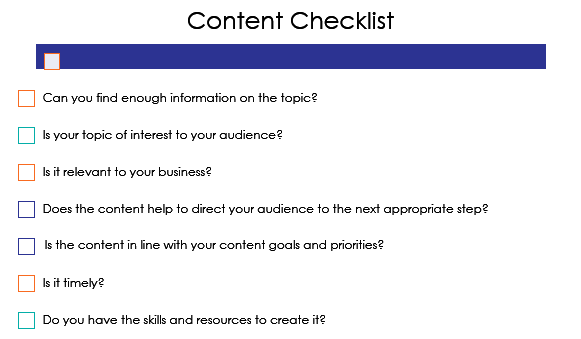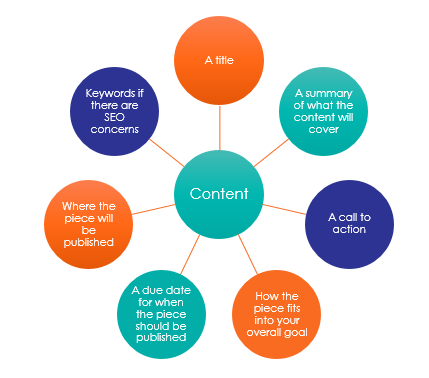Welcome to
Develop a Content Marketing Plan with EaseDeveloping content that will speak to your audience
Module Four
Create Your Editorial Calendar
Once you have a solid content marketing plan and you’re ready to implement it, it’s time to get organized with an editorial calendar. This calendar will keep you on track and organize your implementation so that it goes according to plan.
Your editorial calendar will be at most a three-month calendar with time estimates, responsibilities, resources, deadlines, and everything you need to get started. Each day, you can refer to your calendar and know exactly what needs to get done. And you can always adjust it to add in time-sensitive content when there’s breaking news or hot topics you want to share.
In this module, you’ll get ideas for creating your editorial calendar, but you should tailor it to your own tastes. You may not feel the need to create a checklist for each piece of content, for example. But it’s just one idea to add to your arsenal to create a calendar that works for you.
Brainstorming Content Ideas
Start by brainstorming content ideas for each area. You’ll need to keep creating new content for each area consistently, particularly for Awareness and Relationships, and this content needs to be unique. The best practice here is to make a massive list which you can use as your backburner for content ideas. You can add to this list whenever you get an idea as well. This way, you always have plenty of ideas in stock.
Here are some ideas for coming up with topics:
Repurpose Old Content. We discussed repurposing content in a previous module. As you go about repurposing, you can use your old content to generate new ideas. A few ways to do this include:
- Take another angle. Take the information in one piece of content and reframe it for another audience. Take an article that discusses a topic in the positives and make it negative. Rewrite the content from another point of view.
- If you have an article with tips, take each tip and create a whole new article with additional information, further ideas, or examples.
- Take several pieces of content and write one piece of content that summarizes each in one article.
- Take old content and recreate it in a different format. You can turn text-based content into simple videos; turn videos into audios; make slideshows or infographics out of text content or video stills, and so on.
Remember that repurposed content should still be up-to-date and unique. If you’re offering exclusive content to your email list or creating a paid product, make sure the content isn’t available for free somewhere online!
Your Unique Strengths. Take a moment to identify your unique strengths. These are areas within your topic where you have unique insights or especially great experience. In these areas, you can bring something truly unique and valuable that people can’t get anywhere else. When planning content, choose topics that play to your strengths.
Topics Relevant to Your Product or Service. Try to think of topics that are directly related to your product or service, especially if you’re using content to sell. This works well because people will enjoy your content and find it helpful, which will lead them directly to your product or service.
Topics Relevant to Your Audience. Start with your audience and generate content ideas from them. You have their demographic and psychographic profile. What kind of advice could they use? What information are they looking for? Follow them on social media to see what they’re talking about. What questions do they ask? You can also ask your audience directly through surveys or personal messages.
Follow Your Competitors. Follow your competitors and see what content they’re sharing. Subscribe to their newsletters and follow them on social media. You’ll get ideas you can use for your own content. For example, you might see a video or article that you can put your own spin on. You might see a topic they’re starting to talk about, such as a new social media site worth using. You may also see gaps where there are topics they’re not covering. You can then cover these topics and create something unique.
Watch Your Metrics. Once you start publishing content, monitor closely to see which performs best. The pieces of content your audience reads, downloads, comments on, or shares most are your greatest hits. Try to cover similar topics in similar formats if you can. If a piece of content doesn’t perform well, drop that topic.
Create a Storyline. Try to create a storyline for your content. Think of the order in which your audience will consume your content. Start small and build. Think of each topic as a series of steps your audience has to take. For example, if you write about blogging, there’s a natural storyline there:
- How to get started with blogging
- Choosing a good blogging platform
- Learning about your potential audience
- Generating ideas for your blog
- Creating a writing schedule
- Watching your metrics
Each topic covers another step in a larger process.
Planning a Piece of Content
Whether or not you’ve already been creating content in the past, a bit of planning will help ensure consistent quality. You might want to create a checklist for each piece to help you decide whether to commit to it.
Your checklist would include the following:

- Can you find enough information on the topic?
- Is your topic of interest to your audience?
- Is it relevant to your business?
- Does the content help to direct your audience to the next appropriate step?
- Is the content in line with your content goals and priorities?
- Is it timely?
- Do you have the skills and resources to create it?
As you go about creating content, the above will become second nature, but for now, these are factors to keep in mind when considering each idea.
The Elements of Your Editorial Calendar
There are some elements that should be at the top of your editorial calendar, since they’re part of the “big picture.”
Goal – Include the business goal with which your content plan aligns.
Product, Service, or Topic – Clearly state the product or service that you’re promoting, or the topic in which you’re trying to build expertise.
Content Type – The content types for which you’re creating content. If there are multiple types, you can list them and you may want to categorize.
For each piece of content, your editorial calendar should include:
- A title or a rough idea of a title that indicates what the piece is about (keep keywords in mind)
- The details or a summary of what the content will cover. You may add here what the audience member will know or be able to do by the time they’re finished
- A call to action stating what you want the audience member to do after they’ve finished
- How the piece fits into your overall goal (what it’s meant to achieve; things like “get people to sign up to my email list” or “deepen relationships by offering helpful advice”)
- A due date for when the piece should be published
- Where the piece will be published
- Keywords if there are SEO concerns

Keep in mind that pieces of content can lead to other content. If you have a piece that elicits a response from your audience, such as questions or requests for further information, use this as a cue to create another piece of high-value content directly in response to the wishes of your audience.
If a piece is part of a series, make sure this is clear to your audience. If your audience likes a particular piece of content, consider turning it into a series. If you run a successful series that gets a great deal of engagement, you might consider repeating the process with a similar topic or offering more information in that topic through another format, like a webinar or video series.
As the last two paragraphs illustrate, your editorial calendar should be flexible. Be willing to adjust when necessary. If you have a great idea for content that you know your audience will love, go ahead and make it higher priority, and push the other content back accordingly. This is especially true if there’s some timely industry news you want to share, or if you get a question from a customer that you want to create content on immediately.
For one-time projects, you’ll need to also create an action plan, with tasks and deadlines along with details of what you’re creating. We’ve included example tasks for you in separate tabs in the Editorial Calendar spreadsheet provided. However, you’ll do best if you use a project management platform for that type of content, such as asana or Trello.
Activity:
- Based on your content marketing plan, start brainstorming ideas for the content you decided to create
- Look at the content you already have in each of your four core areas and identify what can be used or repurposed to answer some of the specific questions.
- Based on the plan you committed to, fill in the editorial calendar spreadsheet for your first one to three months of content. Include any resources needed or responsibilities, such as if you’re outsourcing or drawing on team members. See the spreadsheet and Action Guide for more instructions.
A Word
From Tamara
As an entrepreneur myself I completely understand the stress, anxiety and frustration around launching or growing a business. I also know the rewards and life style change the hard work can provide you if you stay focused. I am here to inspire and motivate you to push forward. The fact that you’re investing in your business education let’s me know you’re in this to win. Rest assured I’m here to help you…. These courses are set up to help you understand the basics. To dig deeper into your specific plan of action we will discuss where you are, where you want to be, eliminate any blocks preventing you from getting to the next step and create an action plan.

Our superpower is making you a superhero.

